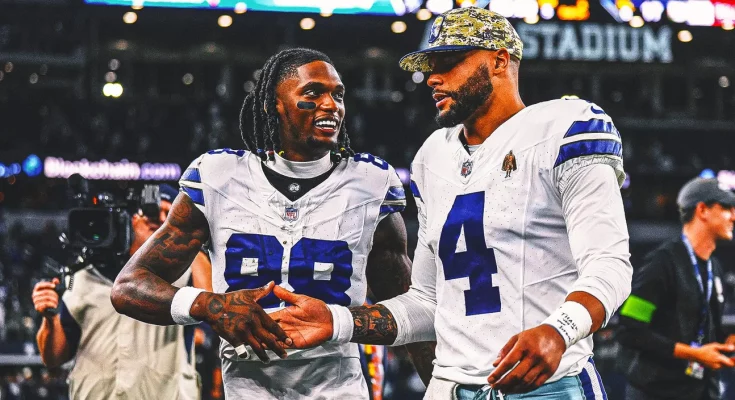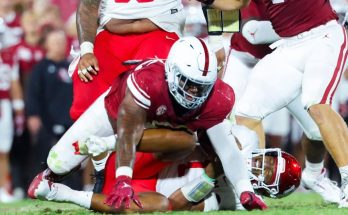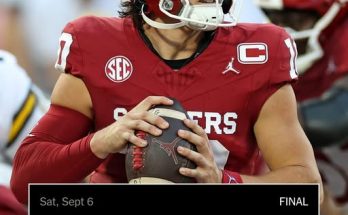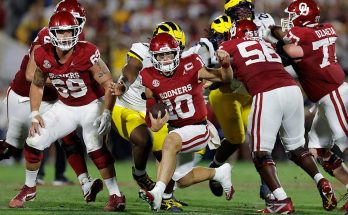Every year, the NFL offseason provides its fair share of soap opera-style drama, and for the Dallas Cowboys—a franchise synonymous with the spectacle of the league—2025 has been no exception. As training camp kicks off, anticipation usually surrounds breakout players, strategic depth chart battles, or a hyped-up rookie class. But this year, any buzz surrounding such narratives has been drowned out by the increasingly visible contract standoff between the Cowboys and two of their biggest stars: quarterback Dak Prescott and wide receiver CeeDee Lamb. These two players, cornerstones of the Dallas offense, are not just focal points on the field—they are also lightning rods for discussions about player valuation, cap management, and the modern dynamics between NFL front offices and their star talents.
The Cowboys enter training camp with a roster that, on paper, has the potential to make a deep playoff run. Defensive coordinator Dan Quinn might be gone, but the defense remains elite. The offense is packed with experienced weapons, headlined by Lamb and, to a lesser degree, Brandin Cooks and Tony Pollard’s replacement. However, with the franchise’s QB1 and WR1 not solidly locked in long-term, the team finds itself navigating uncertain waters. Rather than focusing on playbooks and positional battles, questions at pressers are centered on holdouts, guaranteed money, and the ominous possibility that Dallas might squander its Super Bowl window.
Dak Prescott’s situation is particularly unique—and pressing. He is entering the final year of his four-year, \$160 million contract signed in 2021. That deal, which was supposed to signify stability and commitment, has turned into something of a double-edged sword. On one hand, Dak is clearly the leader of the team. He’s a highly respected locker-room figure, a two-time Pro Bowler, and arguably the most capable quarterback the franchise has had since Troy Aikman. On the other hand, his playoff performance has remained a polarizing topic among fans and analysts. He’s had moments of brilliance, such as the dismantling of the Buccaneers in the 2023 Wild Card round, but he has yet to lead the Cowboys to the NFC Championship Game, let alone a Super Bowl. That lack of postseason success, coupled with a price tag that would only rise in a new contract, makes the front office hesitate.
Complicating matters is the leverage Dak holds. His current deal includes a no-trade clause and a no-tag provision, meaning if the Cowboys don’t extend him before the end of the season, he walks into free agency in 2026—no strings attached. That puts the Cowboys in a tight spot. If they delay an extension and Dak performs exceptionally well, his price could skyrocket into the \$60 million-per-year range, especially with the quarterback market inflating rapidly after deals like those for Joe Burrow, Justin Herbert, and Jalen Hurts. However, if they pay him now and his performance dips—or worse, injuries resurface—they’re stuck with a massive contract and minimal flexibility.
It’s a calculated risk on both ends. For Dak, betting on himself could yield a monstrous payday. For the Cowboys, waiting could backfire. The team’s current salary cap situation doesn’t offer a lot of breathing room, especially with other major contracts—like those of Micah Parsons and CeeDee Lamb—looming on the horizon. The Prescott negotiation isn’t just about his value; it’s about managing a domino effect. Overpaying Dak could hinder the team’s ability to retain other elite talent. Undervaluing him could fracture trust in the locker room or signal to fans that winning isn’t truly the top priority.
Then there’s CeeDee Lamb, who is also seeking a new deal. The 2020 first-round pick has blossomed into one of the NFL’s top wide receivers, compiling a career year in 2024 with over 1,700 receiving yards and 12 touchdowns. Lamb’s ability to stretch the field, dominate one-on-one matchups, and work effectively in the slot has made him invaluable to the Cowboys’ offensive identity. Despite being on his fifth-year option, worth nearly \$18 million, Lamb has so far declined to report to training camp, opting to apply pressure from afar.
In many ways, Lamb’s situation is more straightforward than Prescott’s. The wide receiver market has already been reset multiple times in the last year alone. Justin Jefferson inked a historic deal with the Minnesota Vikings worth \$140 million over four years. Tyreek Hill, Ja’Marr Chase, and A.J. Brown all received top-tier deals that set new benchmarks. Lamb’s camp is certainly aware of these figures and likely views Jefferson’s deal as the floor rather than the ceiling.
From the Cowboys’ perspective, re-signing Lamb should be a no-brainer. He’s young, productive, and marketable—the kind of player Jerry Jones typically loves to keep in Dallas. But the timing is awkward. With Prescott’s contract also unresolved and Micah Parsons expected to command record-setting money for a defensive player, prioritizing financial resources becomes an equation with no easy solutions. The Cowboys may be reluctant to reset the receiver market again so soon after doing so with other stars, particularly if they feel that investing too heavily in the passing game reduces flexibility elsewhere.
CeeDee Lamb’s decision to stay away from training camp, though not unexpected, sends a message. Players have learned that missing offseason workouts doesn’t carry the same stigma it once did—especially for star players with leverage. While technically a hold-in (as opposed to a full holdout), Lamb’s absence is already a distraction. It affects the team’s chemistry, disrupts Dak’s rhythm with his top target, and puts more pressure on young receivers like Jalen Tolbert to step up in practice. More subtly, it raises doubts about the Cowboys’ long-term offensive identity. Can this team really call itself elite if its two most important offensive players are playing under clouded futures?
Jerry Jones and Stephen Jones have said all the right things in public. They’ve reiterated their desire to keep Prescott, Lamb, and Parsons in Dallas for the long haul. But actions speak louder than words, and as training camp trudges forward, the lack of meaningful progress on any of these deals becomes more glaring. The front office has long walked a fine line between calculated patience and organizational paralysis. Waiting too long on Ezekiel Elliott came back to bite them. Letting Amari Cooper go for pennies didn’t exactly age well. One has to wonder if they’ve learned from past mistakes—or if the cycle is doomed to repeat.
The broader lesson here involves how NFL teams now operate in a league where star players are savvier, more unified, and far less afraid to flex their power. Contracts are no longer quiet behind-the-scenes affairs. Players hire high-powered agents, engage in social media campaigns, and use strategic holdouts to create leverage. For organizations like the Cowboys—teams with massive fan bases and media scrutiny—these tactics work especially well because of the enormous pressure to maintain a winning culture and a star-studded lineup.
Prescott’s and Lamb’s stalemates also serve as a microcosm of the NFL’s larger financial structure. With a hard salary cap, teams must constantly juggle future projections, market trends, and player egos. A quarterback contract, especially one for a player like Dak who’s not considered a top-three talent but certainly a top-10 one, becomes a loaded decision. Too much money compromises depth. Too little, and you risk dysfunction. The same goes for wide receivers, who are becoming more valuable in today’s pass-heavy NFL but whose price tags now rival that of second-tier quarterbacks.
One might argue that the Cowboys should simply pick a direction and commit. Either go all-in on the current core—meaning Dak, Lamb, Parsons, and maybe even a few aging veterans like Zack Martin—or prepare for a soft rebuild by letting at least one of these stars walk. But the problem with this binary logic is that the Cowboys don’t operate in a vacuum. They’re trying to win now, while also preparing for a financial future that includes not just player salaries but escalating coaching expenses, stadium maintenance costs, and even unforeseen variables like injury setbacks or coaching staff overhauls.
For now, the only thing certain is that uncertainty reigns in Dallas. While coaches preach fundamentals, young players battle for roster spots, and defensive stalwarts like DeMarcus Lawrence hone their craft for one more championship run, the specter of unresolved contract issues looms large. Every press conference veers toward Dak’s future. Every tweet from a player is analyzed for hints of discontent or negotiation tactics. The usual optimism of training camp feels muted, even subdued. It’s not about football right now—it’s about money, leverage, and what the Cowboys are willing to pay to win.
Eventually, something has to give. Either the Cowboys extend both stars, setting the stage for a well-funded, high-expectation campaign in 2025 and beyond, or they prepare for the unthinkable: a team without Dak Prescott or CeeDee Lamb in the near future. The fans would undoubtedly revolt, and the locker room chemistry might suffer irreparable damage. But that possibility, as implausible as it may sound, underscores just how delicate the situation has become.
Perhaps the only silver lining in all this is that the Cowboys are, at least, dealing with the right kind of problems. They aren’t searching for a quarterback—they’re trying to keep a very good one. They aren’t wondering if they have a WR1—they have a clear-cut superstar. That’s more than a handful of NFL franchises can say. Yet, in a league that punishes indecision and overpays with regret, the Cowboys’ patience is being tested in real time.
In the coming weeks, training camp will continue, preseason games will begin, and players will eventually settle into their routines. But make no mistake: the real action won’t take place on the field. It will happen in boardrooms, during late-night phone calls between agents and executives, and possibly even on Twitter/X, as Prescott and Lamb continue their silent but powerful stand.
The fans are watching. The team is watching. And the entire league is watching. If the Dallas Cowboys want to avoid another decade of “almost,” they’ll have to make tough decisions now. Because while the pads are on and the drills are being run, the future of the franchise is being decided elsewhere—between lines of negotiation, billions of dollars, and the delicate balance between loyalty and logic.



